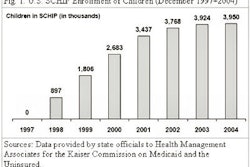Money doesn't grow on trees. If it did, radiology managers and chief financial officers (CFOs) would certainly pluck their fill from the outstretched branches. But imagine picking $400,000 to $500,000 of extra revenue for your facility.
That's the amount that Jamie Heldt, director of imaging and cardiology at Oakwood Healthcare System's Heritage Hospital in Taylor, MI, said her department gathered by hiring its own radiology coder.
Although much debate remains over bringing a coder on board, Heldt believes that her coder's green thumb helped the radiology department's finances grow.
Step 1: Plant the seeds
Robin Russ, director of imaging and cardiology at Oakwood's Annapolis Hospital in Wayne, MI, works in a 200-280 patient facility. At 180 patients, "we're screaming busy," she joked.
But with more than $50 million in annual business transactions, imaging reimbursement is no laughing matter, she said. Especially since an independent auditor found her radiology department captured only 20% of billable revenue.
It's not a problem unique to Russ' department, either. Many radiology facilities simply leave the money on the tree for various reasons. Some do not track claims denials, others do not validate medical necessity, and still others code incorrectly. For all of these reasons and more, says Russ, a designated radiology coder represents the vital financial farmer that facilities need.
"We had to figure out something to resolve this issue," she said.
Step 2: Germinate ideas
Russ joined the Oakwood system's leadership training group. The group included roughly 25 people from all walks of hospital life. Together, the team debated the pros and cons of hiring a specific coder, planted the concept in the minds of their superiors, and communicated the suggestion up the leadership chain to the CFO. The CFO then approved the radiology coder position.
A year and a half after the designated coder started, Russ says, her organization had saved hundreds of thousands of dollars. "It's worked out great," she said.
When Heldt saw her counterpart's success, she moved to enact a similar program in her radiology department.
Use data to support coder claims
Provide comprehensive financial data to prepare others for change, said Jim Sutton, radiology director at Mayo Health System's Fairmont Medical Center in Fairmont, MN.
"Understanding the overall fiscal benefits impresses the higher administrators," Sutton said. "If you show them how hiring a designated coder increases revenue, then you will convince them."
He suggested taking the following steps when making the case for a designated radiology coder:
- Perform a retrospective audit. Learn how much money isn't being collected and why.
- Compare fiscal data of your facility to data of demographically similar facilities.
- Include the financial burden of salary and benefits assumed in hiring a radiology coder.
- Perform additional audits to determine how much lost revenue your facility could save by implementing this new strategy. The more data presented to decision-makers, the better.
"You can extrapolate out what your facility might save," Sutton said. In the case of some facilities, he saw up to $11 million collected.
At Oakwood's Heritage Hospital facility, different charges stemmed from different mistakes, Heldt said. She and her team plotted the mistakes and showed how much the hospital could save by hiring a radiology-specific coder.
Looking back at the data, "we could see actually when our coder started," Heldt said. "Now, we have zero errors."
Step 3: Nourish the idea
Whereas some centers perform self-examinations through front-desk staff and computer programs, others use a designated coder, Sutton said.
Asking "why" and "how" to collect reimbursements is as important as "how much" money you will collect, he said.
When auditing the radiology department, shake the reimbursement tree for additional information as well, he said. Missing data -- not entry mistakes -- accounted for 73% to 78% of claims denials, Sutton noted.
"We really needed to have someone looking at (these) data on a consistent basis," he said.
Step 4: Harvest the growth
In Heldt's Heritage Hospital radiology department, a technologist disenfranchised with advancing imaging technologies sought to retire from her post.
"We saw this as an opportunity," Heldt said. "We wanted to simultaneously provide a new career opportunity for someone we didn't want to lose and boost our reimbursement rates." The former technologist became the department's new coder.
The coder examines numerous variables in reimbursement. Because the coder knows the radiology business, she speaks the clinical language needed to communicate between departmental silos -- from radiologists to technologists to referring physicians.
"She talks to a lot of different departments and to the different offices," Heldt said. "She tells them what we need and why we need it."
Sutton encourages facilities to migrate radiology technologists into designated radiology coding positions.
"The technologists know the medical side of the procedures," he said. "It's far easier for a technologist to look at an interventional radiology report and know that a certain step of the procedure isn't documented."
To start collecting the fruits of the radiology department's labor, put all of these harvesting tools together.
"The money we saved far outweighed the cost of the position," Heldt said. "We recovered $400,000 to $500,000, and that's well worth it, in my opinion."
By Melissa Varnavas
AuntMinnie.com contributing writer
August 7, 2006
This article originally appeared in the "Radiology Administrator's Compliance & Reimbursement Insider," a monthly newsletter published by HC Pro that is designed specifically for radiology administrators. For a free trial subscription, please click here.
Related Reading
Cardiac imaging: The battle for reimbursement, August 4, 2006
Prevent IR coding whirlwind with basics, July 26, 2006
The added value of ACR accreditation, June 13, 2006
Unlock success with strategy, research, April 27, 2006
Preparing for a JCAHO visit, April 18, 2006
Copyright © 2006 HC Pro



















